A global pandemic is an excellent time to waste money, time and energy on expensive social hobbies. Magic has been something of a mythological game for me for almost a decade now. Never quite having the money or social group to get into it, but thoroughly enjoying the game nonetheless. Back seat watching middle class liberals who were all pretty much awful people made up a good portion of my teenage years. As an adult, I am more disillusioned than ever with Wizards of the Coast and the history and narrative of Magic as a franchise.
However, the good game is still good.
EDH (Elder Dragon Highlander) or Commander, is a way of playing Magic that is an absolute hot mess. You can use cards from the entirety of Magic’s history. It has a minimal and soft ban-list. And utilizes 99 card singleton decks – to maximize variance – with 1 card Commanders who you can cast at more or less any point, with which you normally build a strategy around.
The reason EDH works, is that it is normally played with at least four other players, and that people usually are not playing it just To Win. It’s fundamentally a non-competitive format where you try and play at around the same ‘power-level’ as your friends and have a chill time with.
What follows is my (almost) finished first draft of my Nethroi, Apex of Death deck. Or, alternatively, my Biollante deck, since we live in a world where Magic now has collaborations with Godzilla or The Walking Dead. This probably is absolute gibberish if you do not know much Magic, and if you do know much it may still be gibberish.
The Commander, Biollante, and my Goals with this Deck
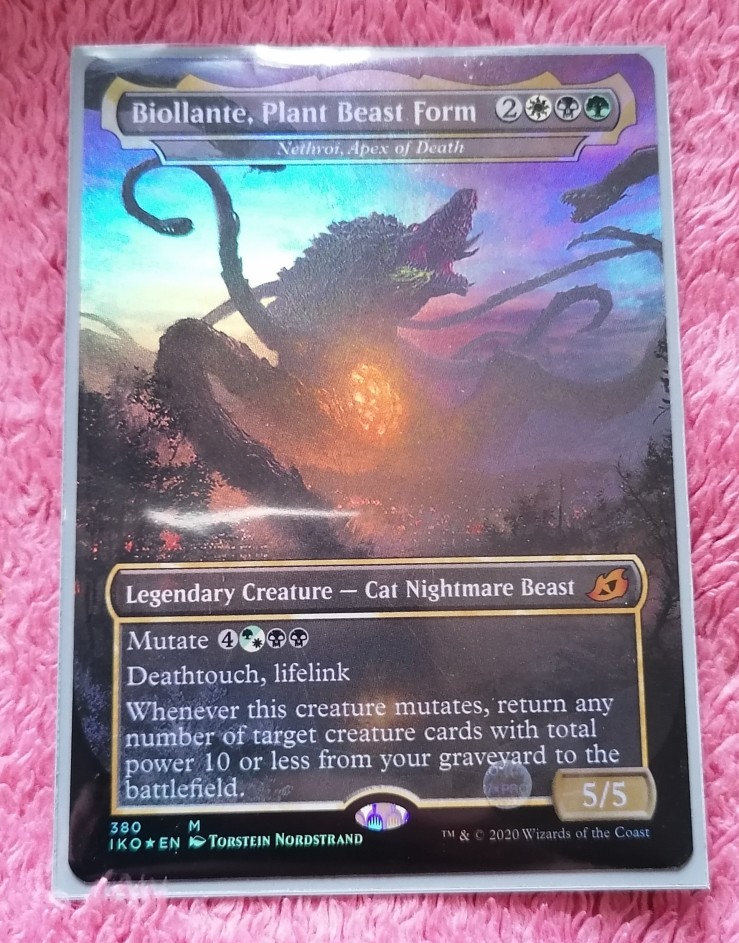
Biollante is the Commander of this deck, and she is core to how this deck will be played. Unlike many Commanders, she is not a ball of powerful stats, though a 5 mana 5/5 with Deathtouch and Lifelink is pretty respectable, and nor does she generate constant value. Instead she works more like a sorcery. Rather than casting her as a creature, we can mutate her on-top of or below a non-human creature, activating her ability which lets us put a bunch of junk from our graveyard onto the battlefield.
Ideally, when we successfully mutate her we win the game. Her ability is that powerful. Unfortunately, 7 mana is alot, and she is weak to both counterspells and regular removal. So my goals when building this deck were as follows:
- Generate a lot of mana, preferably with cheap creatures we can mutate on and with cards that give us extra lands so we can recover from a board wipe.
- Utilize a creature strategy that can win the game if we get back a bunch of it’s pieces from the graveyard with Biollante.
- Put Desolation Angel in this deck, because this colour combination can cast Desolation Angel.
- Try and capture as much fun from the Brawl version of this deck that I ran on MTG: Arena.
Hopefully I will get a chance to play this deck with friends sooner rather than later, and figure out how well I have achieved these goals.
Generating Mana
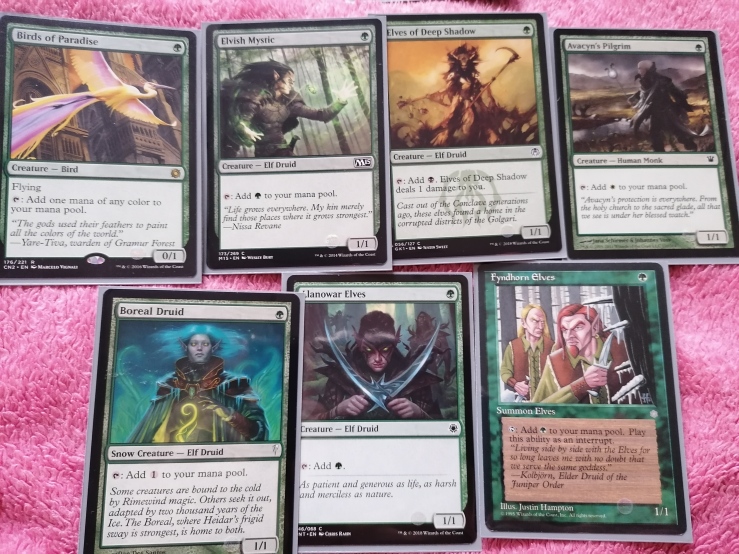
We are running seven 1-mana creatures that can tap for mana. Cheap mana dorks are great at getting us out of the gate as fast as possible. All of these, bar Avacyn’s Pilgrim, can be mutated onto which should let us mutate Biollante efficiently even from an empty board.
Alternate picks here would be Gilded Goose, Deathrite Shaman and Joraga Treespeaker.
Gilded Goose is something of a mana-sink if you can make use of the food, and can fix our mana. However, it does require further mana investment if we want to tap it for mana more than once.
Deathrite Shaman is a super powerful card, but it’s power is somewhat dependent on your playgroup. If you are seeing lots of Fetchlands, it’s probably worth running. If you aren’t, you might want to shy away like I have.
Joraga Treespeaker does require levelling up, but is capable of generating a huge amount of mana for a 1-mana dork.
The dorks I would be inclined to cut for those options are Boreal Druid, as we are not using snow and it generates colourless mana, or Avacyn’s Pilgrim as it is a human.
One concern with these dorks that I do have is that having enough untapped green lands on turn 1 of the game in order to consistently cast them is quite rough for a 3-colour deck. With the ‘ideal’ mana-base I was intending to build I would only be able to cast a turn-1 mana dork when I draw one about 60% of the time. If you want to run more taplands or are unhappy with that here are some more 2 mana or 3 mana suggestions that you can run instead (manabasecrafter.com is a super handy website for finding mana in any colour combination) :
Copper Myr, Gold Myr, Leaden Myr, Palladium Myr and Alloy Myr.
Llanowar Visionary
Deathcap Cultivator
Bloom Tender
Devoted Druid
Sylvan Caryatid and Paradise Druid
Vine Trellis, Overgrown Battlement, Axebane Guardian
Elvish Aberration
Elvish Harbinger
Faeburrow Elder
Incubation Druid
Leyline Prowler
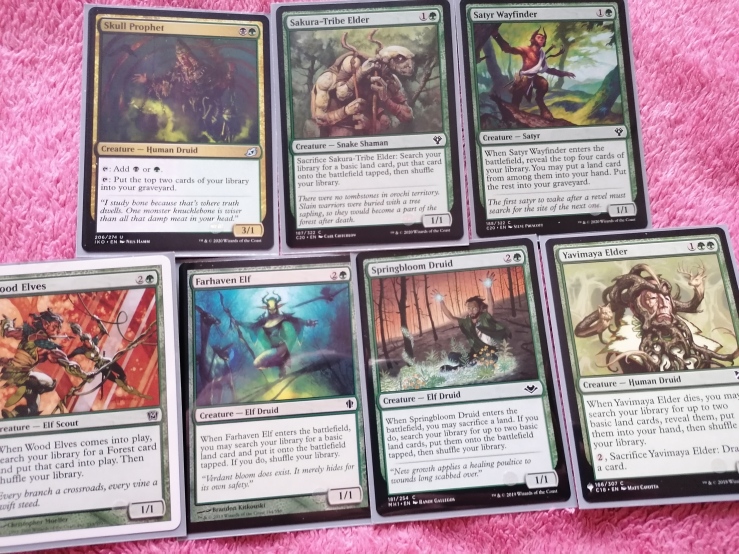
In addition to our 1-mana dorks, we are also running these mana creatures. Most of these either pull lands from our deck, handy for maintaining mana after we get board wiped, or have some other utility that ought to function well in our deck.
In particular, Skull Prophet and Satyr Wayfinder both are mana creatures of some sort, that also fill our graveyard for Biollante.
Yavimaya Elder may be a tad slow for our liking, so if you wanted to make changes here that is the first card I would cut.
We are not running any artifact mana, or other staples like Cultivate or Farseek. Thus with these cards and our intended 37 lands we are running around 51 mana cards in our 99 card deck. This might be too many, but since Biollante is unlikely to resolve when we first attempt to mutate her I am not convinced this is too many. But this is definitely something to be aware of and keep in mind when playing this deck.
The Engine
Since we now know how we are going to cast our spells, next up is how we fuel Biollante and what our particular strategy is going to be.
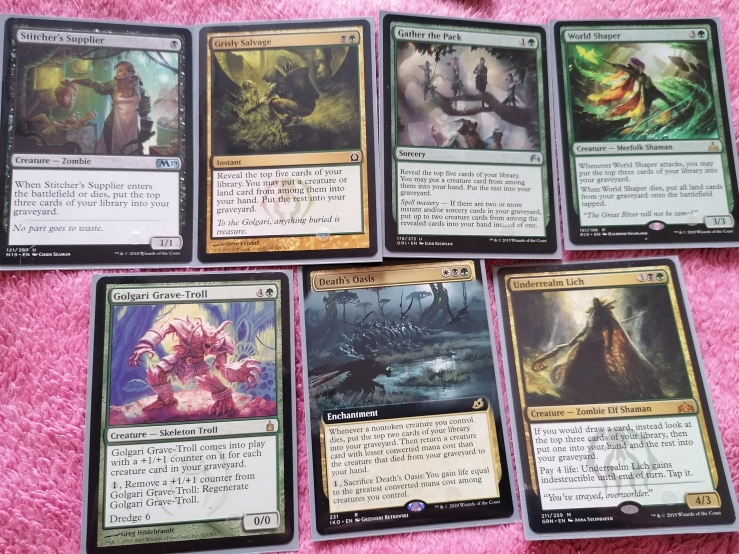
Alongside or aforementioned Skull Prophet, and Satyr Wayfinder, these are our additional ways of putting stuff in our graveyard for Biollante.
Stitcher’s Supplier is honestly a ridiculously efficient card. It both mills and is one more 1 mana creature we can mutate onto. Grisly Salvage and Gather The Pack both fill our graveyard and find us creatures to cast.
World Shaper and Underrealm Lich are much clunkier to cast, but both have quite powerful upsides. World Shaper putting a bunch of lands into play when it dies gives us even more mana to try and actually succesfully mutate Biollante. Whilst Underrealm Lich is card selection and a hard to kill body to mutate onto. Since mutate effects don’t work if the creature you’re mutating onto gets killed in response, and we are not intending to attack with Biollante it’s indestructibility should be quite handy.
Death’s Oasis is one heck of a card. It both recycles creatures from our graveyard and also puts them in there. It even lets us destroy it ourselves if the game goes long and we are at risk of decking.
Golgari Grave-Troll, whilst the king of self-mill strategies may be misplaced in this deck. It is our only actual ‘Dredge’ card and we are not running many ways to put it in the graveyard from our hand to continue the Dredge cycle. On the other-hand, it is a free creature to bring back with Biollante and a tried-and-true Dredger. So whilst I have my doubts about it’s inclusion into this deck I do want to play with it first before deciding to cut it.
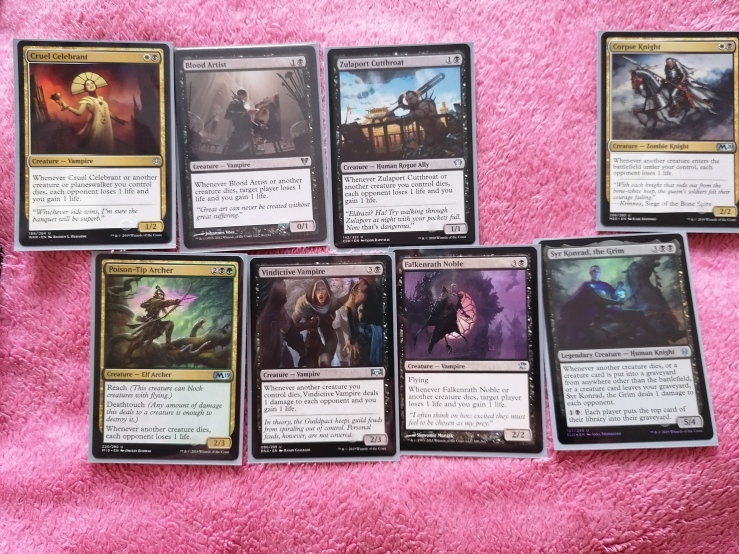
We have decided to use an ‘Aristocrats’ strategy for our main game plan. Aristocrats strategies revolve around cheap creatures, effects like Blood Artist, and sacrifice outlets in order to generate value and deal damage.
This works well with Biollante because it lets us use lots of low power creatures which allow us to bring back more with her effect when we mutate. Lower power creatures means we will find it easier to reach the critical mass we need when sacrificing our board to kill our opponents.
Of these Blood Artist effects I am not looking forward to remember which are ‘target opponent’ and which are ‘each opponent’. Nor which trigger only on our creatures dying, and which trigger on any creature dying. But practice makes perfect.
Corpse Knight and Syr Konrad are somewhat weirder than our other, more redundant, Blood Artists. Corpse Knight does not trigger on creature death but will activate a bunch of times when we mutate Biollante.
Syr Konrad does take up half of our allotted power from Biollante and is a human, which can be an issue. But otherwise, his mill ability is a great mana sink and he will also trigger off Biollante, provided he’s already in play, and our other self-mill cards and so definitely earns his place in this deck.
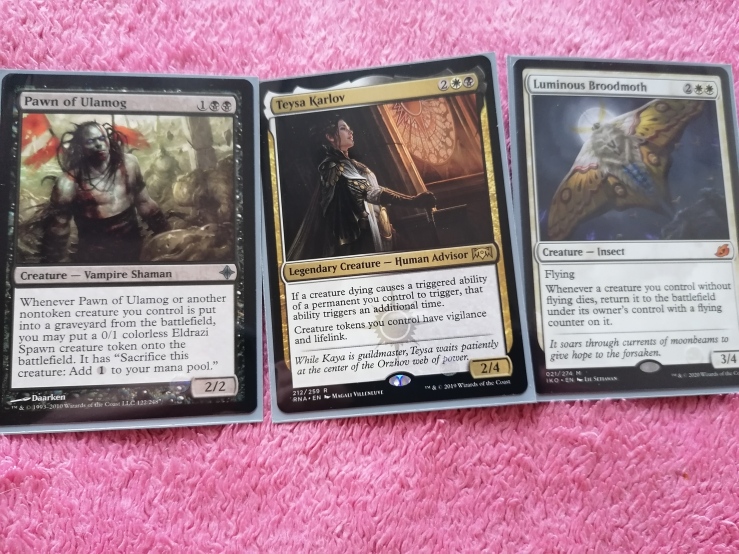
Alongside our on-death creatures, we are also running these three ‘doubler’ creatures.
Pawn of Ulamog gives us token creatures every time a non-token creature dies. These creatures themselves can be used for mana, or also sacced simply for death triggers. This functionally gives us twice as many death triggers when sacrificing our board to a sacrifice outlet.
Teysa Karlov straightforwardly reads “double all your dying triggers” which lets her count as another on-death creature provided we already have on in play, and goes utterly ridiculous if we have multiples.
Luminous Broodmoth is similar to Pawn of Ulamog, but rather than giving us tokens, just gives us the creature again so long as it is not flying. There are multiple ways of going infinite with Broodmoth with minimal investment. Persist, Undying and Medicine Runner all go infinite with her and a sacrifice outlet. Persist and Undying are triggered effects, and since we decide which order our triggered effects triggered at the same time go on the stack, we can alternate between Broodmoth’s ability activating and Undying or Persist’s.
We are not running any of those mechanics or cards at the moment, but this can be changed if I feel like running more win-conditions. Medicine Runner and Geralf’s Messenger are both additions I may make if I find them and desire it later. Medicine Runner is two mana, which lets the combo be searchable with Protean Hulk. Whilst Geralf’s Messenger does not even need a on-death creature in order to wipe the board.
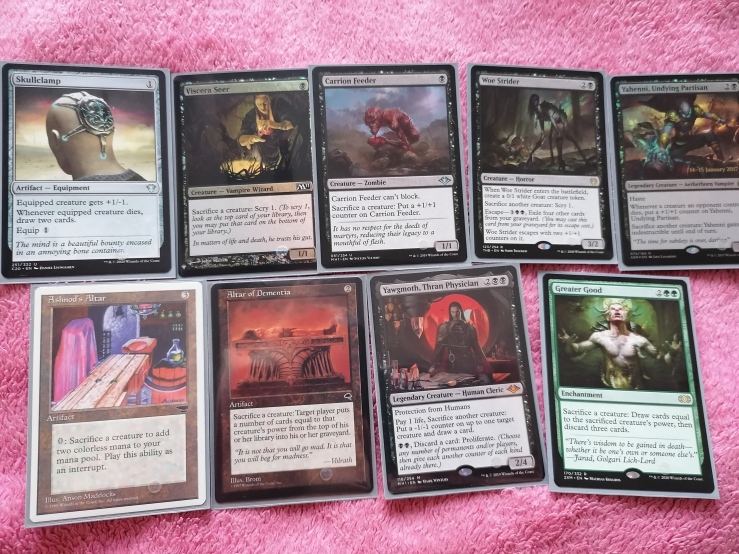
These are our sacrifice outlets. With particular focus given to sacrifice effects that cost very little, or no mana.
Skullclamp is a historically broken card, which lets us turn our mana dorks back into cards. Our mana curve is kinda low for an EDH deck, so having more cards to go with all our mana is probably a good idea.
Viscera Seer and Carrion Feeder are more 1-mana mutate targets, as well as being sacrifice outlets and low power creatures to be brought back with Biollante. A perfect fit for this deck.
Woe Strider might be one of my favourite cards at the moment. It’s a sacrifice outlet. It provides fodder for itself. Scrying is good value. And it even can recur itself quite easily.
We are running two of the traditional three altars because Phyrexian Altar is quite expensive. Given how much I’ve spent elsewhere in this deck, that might not be a great excuse. But for the time being we’ll see how we do with just Dementia and Ashnod’s.
Yawgmoth is another human in this deck that really does not want any humans. But he himself is both a mana-less sacrifice outlet and also draws us cards which is both things we desire. It also is not entirely out there to use his proliferate ability as Politics. If you are so inclined he also combos with Undying creatures if you put a couple of them in your deck for the Broodmoth combo. Provided you have enough life to burn out the table of course.
Greater Good might be a mistake. On the one hand, it is a hard to destroy permanent that can be relied upon as a sacrifice outlet. On the other, all our creatures are bad. So we will probably be discarding a lot of cards when using this. Something to keep an eye on for sure.
Finally, Yahenni is a sacrifice outlet but does not generate much value in and of themself. But, much like Underrealm Lich, they also double up as a hard to kill mutate target. I suspect that will be valuable, but your mileage may vary.
Win conditions, recursion, value and removal
With our core engine out of the way it’s time to fill in the gaps.
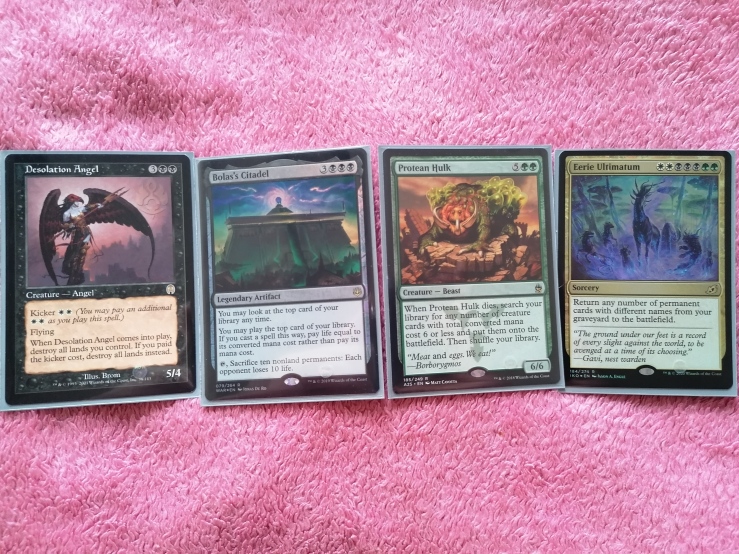
Biollante herself should be our primary win condition. But if she becomes too expensive to cast these are our alternatives.
Desolation Angel is by no means a playable card. Bringing her back with Biollante destroys all our lands, and we do not run powerful enough creatures whereby kicking her is likely to let us beat down our opponents before they can cast spells again. However, we are a deck that can cast Desolation Angel, so we must. If you do not believe in such ethics she should be an easy cut.
Bolas’ Citadel is turning out to be an all-star in many formats and ought to perform well here. Most of our on-death creatures generate life for us. This life we can put back into the citadel and maybe play our whole deck. Scry and self-mill can break up land clumps so hopefully if it resolves it is a somewhat consistent wincon.
Protean Hulk is a traditional combo kill, and whilst we are not cheating it out super early it should provide us with high value even in worst case scenarios. We are running the Karmic Guide + Reveillark combo which is searchable with Protean Hulk provided we have not drawn too many pieces. Sacrifice or kill Protean Hulk somehow -> search out Karmic Guide and Viscera Seer or Carrion Feeder -> Karmic Guide back Protean Hulk, sac K.Guide and P.Hulk to V.Seer or C.Feeder -> search out Reveillark and whatever -> sac Reveillark bringing back Karmic Guide and hopefully a Blood Artist -> K.Guide and Reveillark loop to win. As far as I can tell that is the only combo kill we can search with it, but I have mentioned other combos you may want to run as well.
Finally Eerie Ultimatum is like Biollante, but for our entire graveyard. A stronger, harder to interact with and redundant wincon for our deck.
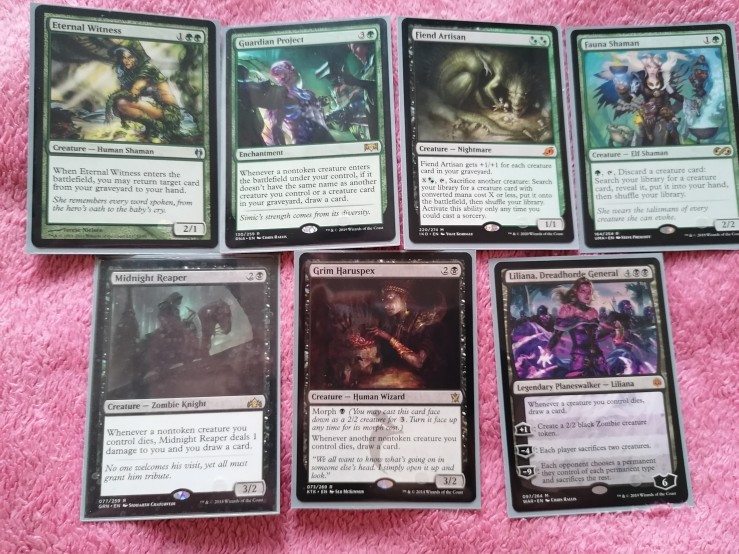
These are our value cards. Primarily focused on ensuring we have Things To Do throughout the game.
Eternal Witness is the staple way for creature decks to get back cards from their graveyard. It may be a human, but unless I am forgetting a functional reprint it’s ability to get back anything we may need is irreplaceable.
Guardian Project is kinda silly card in EDH. Since duplicate creatures are not allowed in EDH, with some exceptions, it is pretty much an auto-include for creature based green decks and here we are, a creature based green deck. I would not expect it to live long, but with a bunch of 1 mana creatures in our deck we should be able to get some value out of it for sure before it dies.
Fiend Artisan and Fauna Shaman are very similar cards. Fauna Shaman edges ahead by synergising with more cards, but Fiend Artisan can also get rather swole. We might not actually want or need these creatures since we are running very few combos, and we may not want to have reliable ways of getting them. Even without searching out combo kills though they can grab us more on-death creatures, more ramp, and whatever utility creatures we want. Very useful.
Midnight Reaper, Grim Haruspex and Liliana, Dreadhorde General are all more card draw cards. Midnight Reaper drawing off itself is incredible. Grim Haruspex can get us out of some very weird locks if necessary. Liliana also doubles as removal for the board and should get us immediate card draw before she dies.
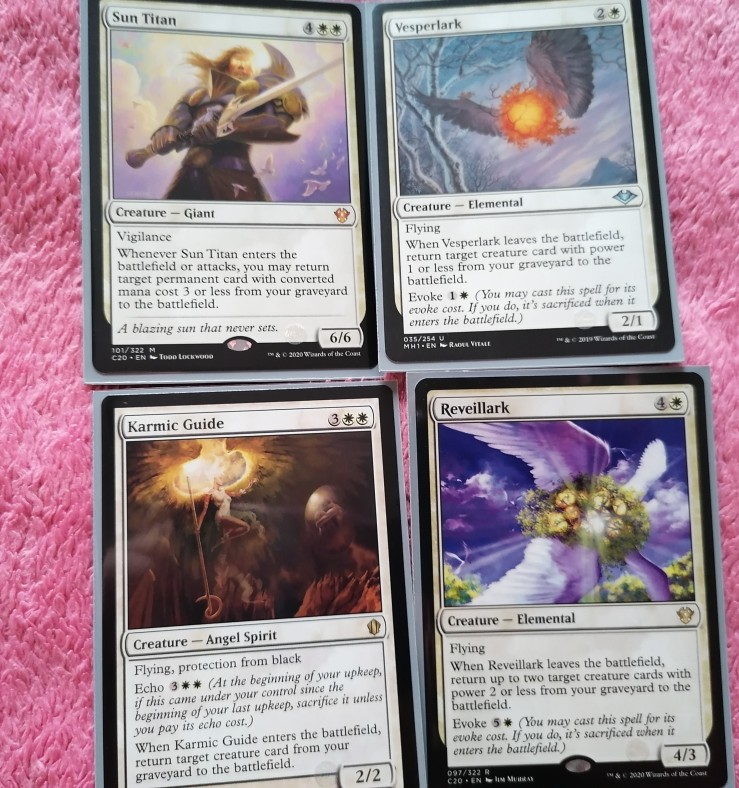 Here is our Karmic Guide and Reveillark combo, as well as a Sun Titan and Vesperlarkfor further recursion.
Here is our Karmic Guide and Reveillark combo, as well as a Sun Titan and Vesperlarkfor further recursion.
The Larks are quite good in our low power deck, though plenty of core cards we run are too big to be recurred by them. Vesperlark in particular may have too few, or too few impactful creatures to get back but it’s too cute not to run.
Sun Titan is a pretty fun staple to play with. It can get back our artifacts, enchantments as well as most of our core creatures.
Karmic Guide is potentially the weakest of our recursive cards. We do not run many particularly strong high cost creatures, but I believe it’s combo potential validates its slot.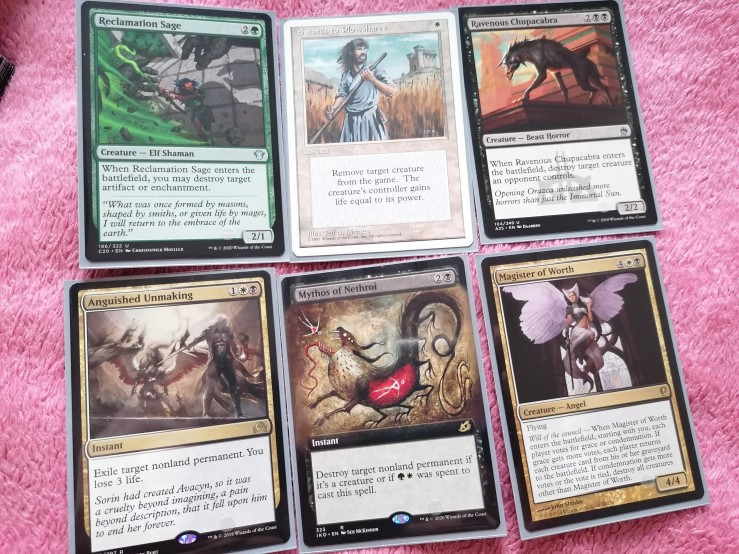
Our final non-land cards are our pure interactive cards. As a synergy based combo deck we are running super light on these slots. This is something you may want to correct by cutting back in other places.
Reclamation Sage, Ravenous Chupacabra and Magister of Worth are all recurrable by Biollante and also by our various recursive creatures.
Reclamation Sage is one of our few answers to Rest in Peace and is almost certainly very important to have on hand.
Chupacabra is not particularly efficient, but it kills more creatures than Nekrataal or Shriekmaw. Demon’s Disciple, Plaguecrafter and Fleshbag Marauder are also options if you aren’t expecting targeting to be necessary.
Magister of Worth is a bit of a weird one but I wanted a wrath that I could recur with Biollante. Recurring her with Biollante is definitely a weird line to take though, but she looks like a fun card to play with.
Swords to Plowshares is the best creature removal in the game. Anguished Unmaking is also super efficient and can hit any permanent. Mythos of Nethroi does not exile, but also hits any permanent. More answers to Rest in Peace.
Lands
I am still working on the manabase for this deck. I should have it something resembling finished when Zendikar Rising drops, but until then I’m around four cards short. Between a potential expedition, potential Pathways and potential Modal Double Faced Lands I trust there is a good job I have a playable deck with the boosters I have preordered at least.
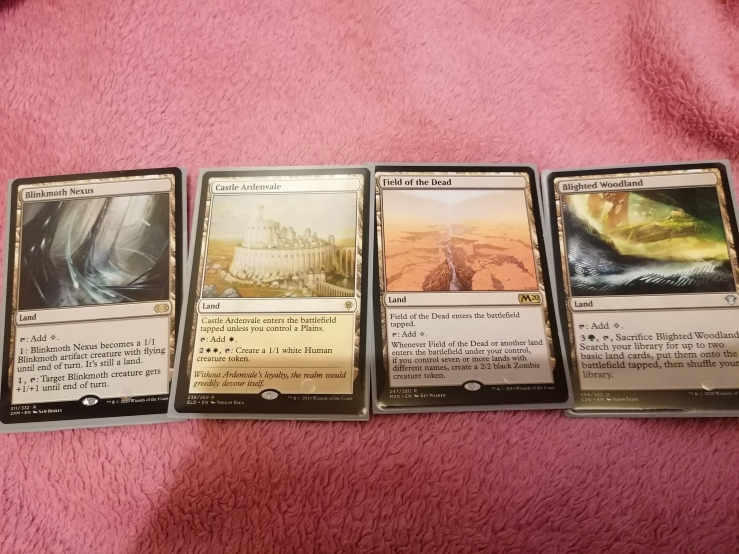
Utility lands are pretty important to have, especially with high land counts. Here I have focused on lands that help us have targets to mutate Biollante onto. At least, that was the intention, except I misremembered Castle Ardenvale. I will be replacing that with a Springjack Pasture instead once that arrives.
I am not entirely convinced that Blighted Woodland, whilst an excellent card, is quite what I am looking for either. I want to play with it a little before looking for a different card to slot in instead.
Other utility lands that you might want to run instead are:
Phyrexian Tower
Castle Locthwain
Gavony Township
Grim Backwoods
Mistveil Plains (Especially if you’re building more combo)
Rogue’s Passage
Sanctum of Eternity
Vault of the Archangel
Volrath’s Stronghold
Frostwalk Bastion
Inkmoth Nexus
Mishra’s Factory
Mutavault
Westvale Abbey
Bojuka Bog
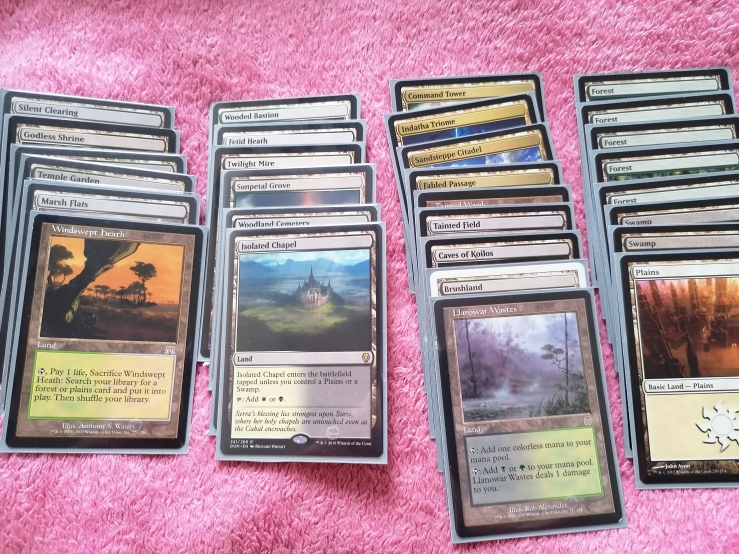
Depending on your budget will depend on if you can do better or worse than me. I would recommend running as many turn 1 untapped green sources as you can if you’re going with 1-mana dorks like I am. Even if that means cutting back on Black/White duals in favour of Green/White duals or Green/Black duals.
Ideally we would want 23 turn 1 green lands for our mana dorks. If you’ve gone with more two mana or higher dorks that goes down to 21. This is EDH though, so try not to stress about this as much as I have.
Cards I own that I might wanna run
I have already given some examples of cards that I or you could be running in Biollante that I am not. But here I will go through some more neat cards that I am keeping in mind for when I wanna do some tweaking
Bane of Progress – We are running very few artifacts and enchantments, though those we do run are somewhat core to our strategy. Initially the slot Liliana was taking was for Bane of Progress, but my one copy of that card is currently in a much worse Mimeoplasm deck.
Acidic Slime, Indrik Stomphowler, Mold Shambler, Sylvok Replica:- Continuing on from Bane of Progress, more options to destroy artifacts and enchantments might be important for a deck so weak to Leyline of the Void, Rest in Peace etc.
Quagmire Druid – A sacrifice outlet and a way to kill enchantments. A bit clunky but worth keeping in mind.
Fiend Hunter – This might compete with Chupacabra. It is only temporary removal but it combos easily several of our cards. It can also function as pseudo wrath protection if we actually ran creatures worth protecting. Unfortunately it is a human otherwise I would run it for sure.
Mirror Entity – Mirror Entity turns our collection of useless dorks into very big useless dorks. I do not believe we need or want a way to attack for lethal. But if we do, Mirror Entity certainly does that. Changelings are humans so we cannot mutate on it either.
Angel of Finality – We are a graveyard deck. Other graveyard exists and are common. Having a way to hit opponent’s graveyards may be a good idea.
Further Dredgers – I have a few other Dredge cards. Depending on how Grave-Troll performs it may be worth putting them in.
Final Thoughts
I am looking forward to playing with this deck. Grindy value decks appeal to me, and taking that ‘grindy value’ and replacing it with ‘killing people’ is still a somewhat novel take to me. Furthermore I have enjoyed playing decks like Jund Citadel and a similar Brawl version of this deck on Arena, so chilling with friends irl and actually playing it in multiplayer should be fun.
I am a tad concerned about it’s power level. Unsure if it is too strong, too weak, functions too well or not at all, but until I play it I won’t know either way.
Further links:-
Decklist on Aetherhub – This may not match this post as edits are made
Manabasecrafter – Somewhat out of date, but a useful resource for all things mana related
Commander Spellbook – A resource for finding and checking combos
EDHRec – Repository of card suggestions and common cards and the commanders they go with
A really cool deck!
I found a Nethroi during my Ikoria pre-release and I always wondered how to build it- This will be a nice reference!
LikeLiked by 1 person